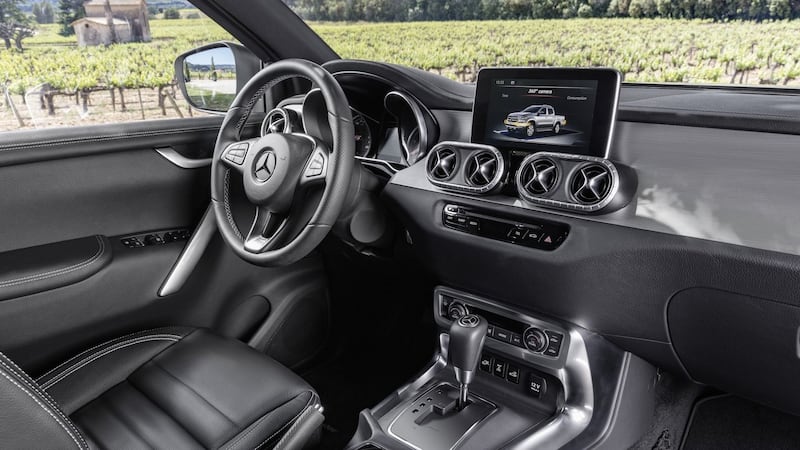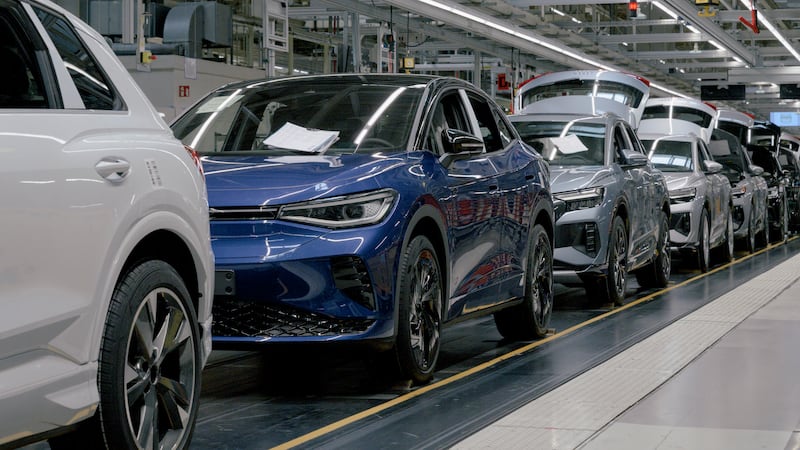It shouldn’t feel odd, but it kind of does. That same kind-of sliding doors sensation that we all got when BMW made its first 4x4. A Mercedes-Benz pickup should not be an oddity - after all, Mercedes has been making commercial vehicles from vans, small and big, to monstrous articulated 18-wheelers - but the new Mercedes X-Class just doesn’t initially compute.
Mind you, the numbers behind it most certainly do. Although sales of one-tonne (that’s payload, not vehicle, weight) pickup trucks is small in Ireland (about 1,500 units a year, and Mercedes hopes to nab around 150 customers for the X-Class in 2018), they are not when you bring the rest of the world into the equation. The market is big, in a global sense, and set to grow by some 40 per cent in the coming years. Mercedes could hardly ignore such a potentially lucrative market.
The German giant was able to bring the X-Class to market relatively quickly, too. It managed to skip the time-consuming investment in a new chassis, new body, new engines, and a new factory in which to bring them all together thanks to Nissan. The Renault-Nissan alliance already has a far-reaching technology sharing arrangement with Mercedes-Benz, hence the shared production of the Smart ForTwo and Renault Twingo, and why the Infiniti QX30 is basically a Merc GLA in a Japanese tailored suit.

So Mercedes was, essentially, able to point at Nissan’s Navara pickup and say “we’ll have some of that, thanks.” Of course it’s not quite that simple. Both pickups are built in the same factory in Barcelona, and they share a chassis, structure and, for now, 2.3-litre and 2.5-litre turbo diesel engines. There are some significant differences, though.
The Mercedes is wider than the Nissan, buy 70mm, and lower by 20mm. And while the overall shape is very similar, Mercedes swears blind that there’s not a single panel on the exterior which is common to both cars. Even the angled kick-up in the rear side window is slightly, subtly, bloody-mindedly different. Mercedes will, next year, introduce its own 3.0-litre V6 diesel model, a modification which caused Nissan to modify the chassis of the Navara to make it more crack-resistant, something which had been causing the Japanese car maker no end of bad publicity in pickup circles.
The four-cylinder engine is the same as the Navara’s, though. It’s Nissan’s 2.3-litre four-pot turbo diesel, in either 163hp form (which Mercedes badges as X220d) or 190hp (X250d). The more powerful engine gets a hefty 450Nm of torque, produced at a low, rumbling, 1,500rpm. And it is almost impossible to stall. On a dripping wet day, we tried the X-Class out on the slimiest, soppiest, muddiest terrain that Co Kildare could concoct. While it’s hardly a representative test (Mercedes says that it will be surprised if many X-Classes ever get mud on their undersides) it was pretty impressive.
As ever, no car maker is ever going to let journalists loose on a course that it isn’t 100 per cent certain its car can easily tackle, but the X-Class shrugged off mud, rocks, trees, a river, and more with insouciance and a gun-dog-like happiness at finding itself up to its shoulders in mud. At one point, in low-range first gear, it chugged up a 30-degree incline on just tickover. Those mourning the death of ‘proper’ off-roaders such as the Land Rover Defender should look no further.
Anyone switching from a Defender to an X-Class is likely to be stunned insensible by the silence. The Navara is already and entirely adequately refined vehicle, but the X-Class is definitely more so. Mercedes has built its own upper structure for the car, and added more sound-deadening, so the rumbles and grumbles of the engine definitely feel at one further aural remove. Fitted with Merc’s own seven-speed automatic gearbox (a nine-speed version will likely be offered at some point) the X-Class isn’t fast, but it flows nicely with traffic and uses its beefy torque figure to allow you to exploit gaps between other cars on the motorway.
It’s not entirely car-like to drive (with a separate chassis and hefty body, how could it be?) but the standard-fit coil-spring rear suspension (as opposed to the crude leaf springs of many rivals) mean it’s actually pretty decent, and the steering is, if slow, well-weighted and accurate. Just beware of its length if you’re planning to take it into city centre car parks.

The cabin is pretty much entirely Merc-sourced and we struggled to spot any carry-over Nissan parts on the inside. Front seat passengers sit on big, bulky, comfy chairs, and all the switches and most of the plastic surfaces feel of good quality. It’s no E-Class but by pickup standards it’s pretty lush. Not so in the back, though, where headroom and legroom are pretty limited. The kids with definitely be complaining.
Actually, that last point brings us to the question of who’s going to buy the X-Class. Mercedes reckons that 65 per cent of its sales will come from the mid-ranking Progressive spec, with the builder-spec basic (rear-drive) Pure model only accounting for a minority of sales. So this isn’t a car for the construction site, it’s for leisure purposes? Not quite, says Merc.
A quirk of the Irish tax system means that if you want to buy a commercial vehicle and use it for social, domestic, and pleasure purposes, you have to revert to the old engine-capacity tax system which means you’ll have to pay €994 a year in motor tax, rather than the commercial vehicle rate of €333. But Mercedes expects all customers to register and tax their X-Classes as commercials.
Are they expecting owners to pay the €4,000 fine if they get caught bringing the kids to school? Or is this a tacit admission that this is an effectively-unenforced area of tax law? Mercedes own policy of mixing and matching X-Class sales between seven dealers in Ireland, a mix of van and car dealers, seems to reflect this dichotomy, as does the X-Class’ marketing, which shows it being used for everything but hauling tools to a building site.
Perhaps that’s something for an owners’ individual conscience. Legality aside, the X-Class is yet another one-tonne pickup that’s actually pretty roundly impressive. It obviously has the off-road ability and load-lugging capacity to be a serious workhorse, but there’s enough luxury and refinement in it that you might not need a second car.
Which is just as well. The basic, no-frills model starts from €39,950, while the big-selling Progressive is €43,995. And our Power test car? An eye-watering €52,550. We like, even love, the rufty-tufty honesty of pickup trucks, but does that still work once you’re paying premium prices for a premium brand?
The lowdown: Mercedes-Benz X-Class X250d Power.
Price: €52,550 as tested. Range starts at €39,950.
Power: 190hp.
Torque: 450Nm.
0-100kmh: 11.8sec.
Top speed: 175kmh.
Claimed economy: 35.7mpg (7.9 litres/100km).
CO2 emissions: 207g/km.
Motor tax: €333 as commercial, €994 as private car.
Verdict: Rugged and tough but with Mercedes comfort and refinement. A compelling combo, if you can get your head around the tax.
Our rating: 3/5














